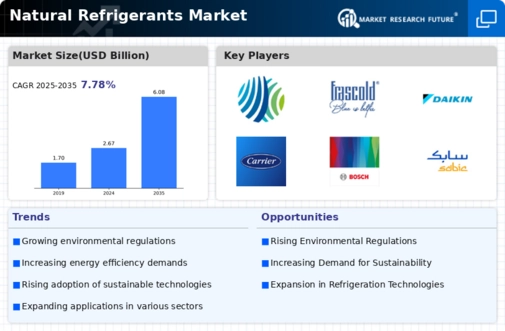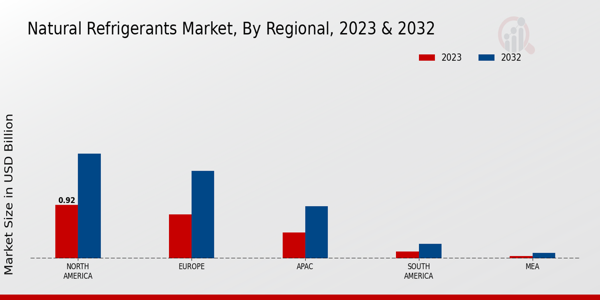Regulatory Support
The Global Natural Refrigerants Market Industry benefits from increasing regulatory support aimed at reducing greenhouse gas emissions. Governments worldwide are implementing stringent regulations to phase out high global warming potential refrigerants, thereby promoting the adoption of natural refrigerants. For instance, the European Union's F-Gas Regulation encourages the use of alternatives like ammonia and CO2. This regulatory framework is expected to drive the market, contributing to its projected growth from 2.67 USD Billion in 2024 to 6.08 USD Billion by 2035, reflecting a compound annual growth rate of 7.77% from 2025 to 2035.
Cost Competitiveness
The cost competitiveness of natural refrigerants compared to traditional refrigerants is a crucial driver for the Global Natural Refrigerants Market Industry. As the prices of synthetic refrigerants rise due to regulatory pressures and phase-out strategies, natural refrigerants are becoming more economically attractive. For instance, hydrocarbons like propane and butane are often less expensive and readily available. This economic advantage is encouraging businesses to transition to natural refrigerants, particularly in sectors such as food and beverage, where cost efficiency is paramount. The market is expected to see a significant uptick as more companies recognize the financial benefits of adopting natural refrigerants.
Market Diversification
The Global Natural Refrigerants Market Industry is witnessing diversification across various sectors, including commercial refrigeration, air conditioning, and industrial applications. This diversification is driven by the increasing recognition of natural refrigerants' benefits, such as energy efficiency and lower environmental impact. Different industries are exploring tailored solutions that incorporate natural refrigerants, leading to a broader application range. For example, the food and beverage sector is increasingly adopting CO2 refrigeration systems for their efficiency and sustainability. This trend is likely to enhance market growth as more sectors embrace natural refrigerants as viable alternatives.
Environmental Awareness
Growing environmental awareness among consumers and businesses is a significant driver for the Global Natural Refrigerants Market Industry. As climate change concerns escalate, stakeholders are increasingly seeking sustainable solutions. Natural refrigerants, such as hydrocarbons and ammonia, are recognized for their low environmental impact and energy efficiency. This shift in consumer preference is prompting manufacturers to innovate and adopt eco-friendly technologies. The market's expansion is further supported by initiatives promoting energy-efficient systems, which are anticipated to enhance the adoption of natural refrigerants in various applications, including refrigeration and air conditioning.
Market Growth Projections
The Global Natural Refrigerants Market Industry is poised for substantial growth, with projections indicating a rise from 2.67 USD Billion in 2024 to 6.08 USD Billion by 2035. This growth trajectory suggests a compound annual growth rate of 7.77% from 2025 to 2035. The increasing adoption of natural refrigerants across various applications, driven by regulatory support and environmental awareness, is likely to contribute to this expansion. As industries continue to seek sustainable solutions, the market is expected to flourish, reflecting a broader trend towards eco-friendly practices in refrigeration and air conditioning.
Technological Advancements
Technological advancements in refrigeration systems are propelling the Global Natural Refrigerants Market Industry forward. Innovations in compressor technology, heat exchangers, and system design are enhancing the efficiency and performance of natural refrigerants. For example, advancements in CO2 refrigeration systems have led to improved energy efficiency and lower operational costs. These developments not only make natural refrigerants more viable but also align with the growing demand for energy-efficient solutions in commercial and industrial applications. As technology continues to evolve, it is likely to further stimulate market growth and encourage wider adoption of natural refrigerants.





















